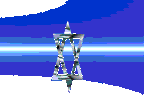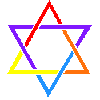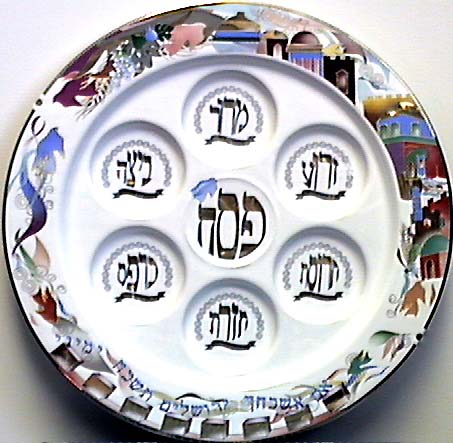




This page was created for my site by my friends Mike Shaer and Malcolm Wald.
V. Savelieva
Passover: History and Meaning of Freedom in Faith
Passover celebrates the Jewish people's freedom from Egyptian bondage that took place over 3,000 years ago, as told in the biblical Book of Exodus. Under the reign of Pharaoh Rameses II, the Jewish leader Moses led his people out of Egypt after a series of 10 plagues that Moses warned the Pharaoh would devastate his people, if he refused to let them go. After each plague, the Pharaoh agreed to let the Hebrews go, but the Pharaoh soon changed his mind and continued to hold the Hebrews as slaves. Finally, after the 10th plague, the Pharoah let the Hebrews go for good. However, after the Hebrews left in a hurry, in fact so quickly that they did not have time to bake any bread for the trip to Canaan, and instead baked unleavened bread, called Matzah. The Pharaoh, being very fickle, changed his mind and sent his army into the Sinai desert after the Hebrews. The Hebrews had been wandering for 40 days and 40 nights down the Sinai peninsula until they reached the Red Sea. When they saw the Egyptian army fast approaching toward them, they called out in despair to Moses. Fortunately, g-d intervened and commanded Moses to strike his staff on the waters of the Red Sea creating a rift of land between the waves, enabling the Jews to cross over the Red Sea to safety on the other side. G-d then commanded Moses to strike the waters of the Red Sea again, just as the Egyptian army followed them through the parted Red Sea. The waters came together again, drowning the entire Egyptian army and the Hebrews were saved.

While the Hebrews were in Egypt as slaves, building cities at the hands of cruel taskmasters, the Pharaoh noticed that their population was becoming too numerous for his comfort. He then decreed that the first born male of every Hebrew family be put to death, in order to reduce this population threat. G-d then instructed Moses to tell the Hebrews to spread the blood of a lamb on the doorposts of each Hebrew home, so that the Angel of Death would 'pass over' the Hebrew homes, and instead slay the first-born male of every Egyptian family. The Hebrews were saved from this tragedy, but nonetheless were ordered by g-d to remember to say prayers for the slain Egyptian sons and later on, the drowned Egyptian army.


Since the time of Jewish freedom from Egyptian slavery, Jews have celebrated this historical event by having a feast called the 'Seder'. The word 'Seder' means 'order' and refers to the order of historical events recalled in the Passover meal as well as the meal itself. The story of Passover is read from a book called the 'Haggadah'. While the main story of Passover is read by Jews the world over, local customs and traditions have changed over time, so that the festival has been adapted to reflect the life and routine of individual communities. This is why the festival of Passover is celebrated differently in Tunisia than in Canada.Passover is celebrated for 8 days (7 for Reform Jews), and always begins on the 15th day of the Hebrew month of Nisan.

There are 7 main symbolic foods on the Seder table that remind the Jewish people of their time of slavery in Egypt. This Seder plate shown below displays in Hebrew the names of each of the foods.

The 7 symbolic foods of Passover are:
1. Matzah: Unleavened bread similar to a cracker and symbolizes the Hebrews' slavery in Egypt. When the Hebrews were hastily preparing to leave Egypt, they had no time to bake leavened bread and instead baked the unleavened bread known as matzah. According to tradition, the original matzah was baked in 18 minutes.

2. Haroseth: A mixture of crushed nuts, apples, cinnamon, and honey, which symbolizes the mortar the Hebrew slaves in Egypt used in constructing buildings for the Pharaoh.
3. Egg: A hard-boiled egg is used to symbolize life and rebirth.
4. Salt Water: The egg is dipped in salt water which symbolizes both the tears of oppression as well as of joy in freedom.
5. Maror: This is very bitter horse-radish that symbolizes the hardships of slavery. It is very strong. I mean it. It makes my face red, my eyes tear and clears my sinuses!!!
6. Karpas: This is a mixture of boiled potatoes or radishes, and parsley which is dipped in salt water and symbolizes the undernourishment of the Hebrew slaves, as well as the new Spring season.
7. Z'roah: This piece of meat, sometimes represented as a shankbone, symbolizes the Paschal lamb and refers to g-d's rescuing of the Hebrews from Egyptian slavery.

The Passover seder not only symbolizes a Feast of Freedom from slavery, it also represents a reminder of gratitude for maintaining faith in one's beliefs. The leader of the seder sits at the head of the table, and then washes his/her hands to symbolize a new beginning or 'passing over' from slavery to freedom. The traditional Kiddush is recited by the leader of the seder, and involves the blessing over wine to g-d for having been taught the lesson of Passover, and its meaning of faith in one's beliefs. The matzah is broken into two pieces, not of the same size, and this splitting represents the parting of the Red Sea. The larger portion is called the Afikomen and is placed under a napkin and the smaller portion is put between the other matzot. This is followed by an announcement from the seder leader to people at the seder table to join around, and have a piece of the Matzah, also known as 'the bread of affliction'.

The Four Questions Traditionally given to the youngest person at the seder table(usually the youngest child) to read aloud, the Four Questions are a short but complete overview of the story of Passover told in the Haggadah, or book of Passover, which is given to each person at the table. It illustrates the uniqueness of the Passover holiday, as compared to other times of the year.

The Four Children The Four Children represent different methods of reading the Passover story to people with different types of personal attributes. One child is wise, another is slow, still another is wicked, and the final one is silent. The reciting of the story of Passover to match the different abilities of various people, is also a reflection of the flexibility inherent in freedom, as opposed to the rigidity of slavery.

Passover in Songs There are many happy songs that are sung in joyous reminder of having been released from bondage. The most famous song is the melody 'Dayeynu', which records the many ways that g-d sided with the Hebrews. At the end of each mention of g-d's favours, the word 'Dayeynu' is sung, meaning 'it was enough'.
The people at the Passover table then eat the symbolic foods, including two pieces of matzah surrounding the Maror mixture, called 'Hillel's Sandwich'.
After these rituals are finished, the complete dinner is then served. People at the table now eat while realizing that just as they were hungry waiting for the meal to begin, they could imagine in just a small way, what it was like for the Hebrews to experience the hardship of slavery and hunger. After the meal, the Afikomen is eaten, although there is a tradition in some households that the Afikomen is hidden prior to the start of the meal, and that the children look for it once the meal is finished. The child who finds it gets a chocolate coin or other prize.

The Prophet Elijah and Passover The closing of the Passover seder is highlighted by the 'Redemption Theme', as well as a reminder that the joyous festival of Passover is to be shared with the less fortunate. The Prophet Elijah, symbol of the humble wayfarer, is invited to enter the home through the symbolic opening of a door to the house. The Cup of Elijah, filled with wine, and represented in the left border of this web page, is confirmation of the hope of Elijah's arrival into the house. After opening the door for Elijah followed by a small period of time waiting for him, the Passover seder service is finalized by the selection of Psalms, or Songs of Praise, known as the 'Hallel'. The Passover dinner is ended with a drink of wine. All foods and drinks served at the Passover meal carry a significant symbolic meaning and weight on the guests' mind and the recital of the Passover story and its rituals serve to remind the person of his/her importance, enabling the person to be aware of gratitude and, just as important, widen an individual's perspective of himself/herself in relation to his/her fellow human beings. Passover carries a sense of humbleness to the self, placing one's frame of mind in a more balanced proportion relative to one's immediate surroundings and to the universe as a whole. Self-centeredness can magnify one's view of the world to the point where one can only see oneself more than one can see one's environment. The Feast (and Feat) of Freedom, called Passover, is a shining example of a meaningful story showing g-d's intent to convey a psychological balance between the Hebrews' self-concerns and the concerns of their enemies, the Egyptians, as g-d reminds the Hebrews to pray for the fallen Egyptian army and the slain first-borns of the Egyptian families by declaring to the Hebrews that 'the Egyptians are my creation as well'. Thus, Passover's concept of personal and collective freedom is not only a cause for celebration, but a strong lesson in the value of proportion and balance in how a person should conduct oneself or a group should conduct itself in relation to other human beings. Shalom!
A toast to all, in Hebrew: L'Chayim! (To life!)
L'Chayim! (To life!)

The McPassover Story (for those who like to read on the run) Passover is the Jewish holiday that celebrates and memorializes the freedom of the Hebrews or Israelites from slavery in Egypt and takes place near the end of March or beginning of April. During the first two nights, there are gastronomic marvels and readings from the Haggadah, with prayers, singing, and blessings, which occur in a specific "order" or sequence. The meaning of 'order' in Hebrew is coincidentally, "Seder". The youngest child (it was always me, in my family) recites the four questions, and the traditional head of the family, usually the grandfather, recites the readings from the Haggadah. No food containing yeast (called 'Chometz' in Hebrew) is allowed in the house during the holiday of Passover. This symbolizes the unleavened bread that the Israelites or Hebrews made in haste, as they were fleeing Egypt.
The Best Passover Recipes: from my grandmother to my mother to you. 1) Matzah Balls or Knaidlach: My bubby made them hard as rocks, but they were magnificient. To this day, no one in the family can duplicate her recipe, despite many attempts.
Ingredients: 2 tbsp. chicken fat or oil, 2 eggs, 1/2 cup of matzah meal, 1 tsp. of salt, 2 tbsp. of water or chicken soup.
Instructions: Mix the chicken fat with the eggs. Combine the matzah meal with the salt blending thoroughly. Add the water and gently stir it then leave alone for 20 minutes. Get a cup of coffee or tea, and relax with your favourite magazine or newspaper. Or even better, call your children and ask them how they are, and what's new? Next, mold the matzah meal into small round balls. The size is up to you. Some like small ones, some like bigger ones. It's pretty much like men's tastes in breast sizes!!! Jerry Seinfeld likes "buxom" women. No comment from me. I'm just glad to eat the delicious matzah balls whatever size. Where were we? Oh, yeah. Matzah balls. Take them and add them to simmering home-made chicken soup. Let them simmer in there for 20-30 minutes to absorb all the flavor of the soup, and then serve. Makes 8-10 balls. Not bad. I wonder if George Steinbrenner of the New York Yankees can borrow some of this for his ball team.
2) Bubby's Foolproof, Tamper Proof, Idiot Proof Matzah Balls:
Ingredients: 3 eggs with separated yolks and egg whites, 3/4 cup of matzah meal, 1/2 tsp. of salt.
Instructions: Beat the egg whites until firm. Do the same for the yolks, not jokes. Add matzah meal and salt. Mold into balls (size is your call). Then place them into boiling water or for you chemistry buffs, dihydrogen monoxide, or soup stock. Place a cover over the pot, and simmer for 45 minutes for the matzah balls to absorb the flavor of the soup. It should be in a pot by this time, silly! Take the matzah balls out with a spoon with holes. I can't remember the technical name for this spoon, but you know which spoon it is. It has holes in it, so the liquid stuff is drained away. Makes 10-20 matzah balls. YUMMY! Note of Advice: My bubby says to refrigerate for 20 minutes before molding the matzah meal into balls. She is the "resident" expert, so listen to her.
Source: "Second Helpings, Please!" by Norene Gilletz, Roslyn Brown and Rae Wander, 1967.
Here are some beautiful Passover paintings by Baruch Nachshon, an Israeli Artist.
How about some Passover recipe links to get you more in the mood?
We've collected some here just for you:
A Kosher Passover
Passover Cyber-Kitchen
Kosher Cooking